Small Black Bugs on Plants (Including Tiny Bugs) – Pictures, Identification and Control
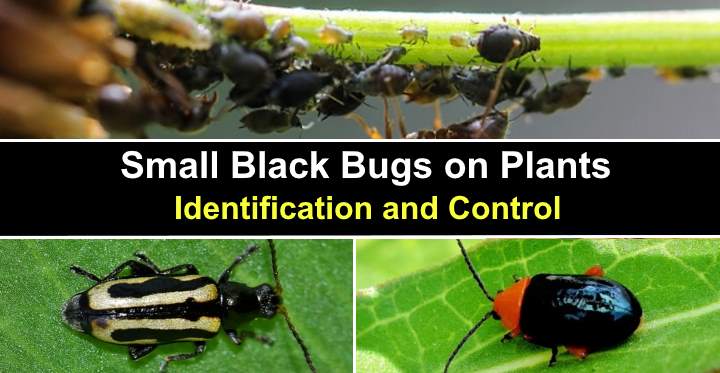
Small black bugs on plants are more than just a nuisance. Tiny black bugs like black aphids, thrips, and spider mites can damage plant leaves, affect their growth, and even kill your prized houseplants. Little black bugs injure plants by biting into the plant tissue and sucking on juices. And even though the bugs look like tiny black seeds, getting rid of them can be challenging.
Eradicating tiny black bugs from houseplants requires identifying the type of insect, mite, or fly that’s doing the damage. It is also essential to care for your plants’ health to prevent them from attracting pesky plant-destroying bugs. Of course, you should always check plants for small black or white bugs when bringing them into your home.
Black Bugs Vs. Black Insects
It is common to refer to any type of black plant pests as bugs. However, not all are in the scientific class of true bugs—Hemiptera. Bugs are tiny insects with piercing mouthparts for extracting plant sap. Additionally, bugs rarely have wings. However, this article refers to all small black insects that cause plant damage as bugs.
This article is a comprehensive guide to identifying common types of tiny black bugs that can infest your plants. You will also find out how to spot signs of plant damage and kill small black bugs for good.
How to Identify Small Black Bugs on Plants
Tiny black bugs come in many different shapes and sizes. To identify them correctly, it is vital to recognize their specific habits and traits. For example, some little black bugs swarm around plants, whereas others lurk under leaves and are barely visible. You should also check for plant damage like yellowing leaves or wilted stems.
Minuscule black flies are typically fungus gnats that live in the soil. Black aphids and thrips may look like tiny black specks of dust. And dark-colored bumps on plant stems could be black scale insects.
Signs of Small or Tiny Black Bugs on Plants
Tiny black bugs can be very destructive pests and cause extensive plant damage. They feed off plant foliage and stems by sucking out their sap. They also spread viruses and bacteria, causing diseases. These usually result in spotted leaves, leaf curl virus, sticky honeydew, or silky strands.
Types of Small Black Bugs on Plants (Overview)
Typical small black bugs that affect plants are fungus gnats, aphids, black flea beetles, spider mites, scale insects, and thrips. You will generally find the tiny bugs under plant leaves or stem joints. Usually, you’ll only notice the almost microscopic dark bugs when they start causing plant damage.
Tiny Black Bugs on Plants
There are several types of black bugs in the order Hemiptera. Some of the common tiny black bugs on plants are aphids, scale, and thrips. Some of these black plant bugs are so tiny that they are less than 0.04” (1 mm) long. Also, some sap-sucking black aphids and destructive black thrips can develop wings and fly to nearby plants.
How to Get Rid of Small Black Bugs on Plants
Tiny black bugs are challenging to eradicate from plants. It’s best to use natural, organic methods to rid your prized houseplants of the destructive pests. Natural solutions for eliminating the bugs include a neem oil spray, insecticidal soap spray, or rubbing alcohol.
A crucial step in ridding plants of nasty pests is controlling their numbers. Many people use yellow or blue sticky traps to prevent further infestations. It’s also a good idea to isolate infected plants while treating them for bugs.
Types of Small Black Bugs on Plants (with Pictures and Identification)
Suppose you notice tiny black specks on leaves and want to know what they are. Or you see little bugs that look like black seeds and want to get rid of them. If so, please continue reading to learn how to identify small black bugs on plants.
Fungus Gnats
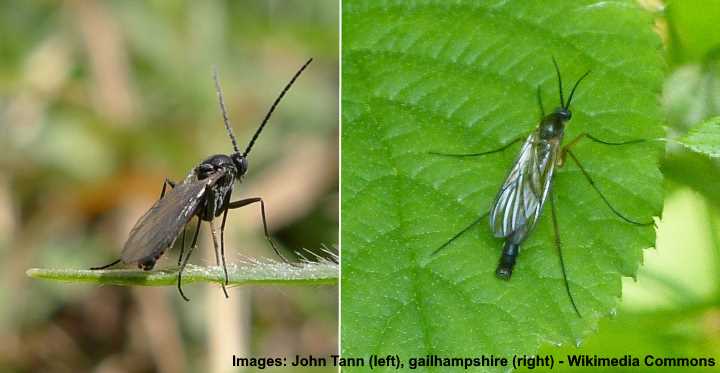
Fungus gnats (soil gnats) are soil dwelling small black houseplant pests that feed on fungus
Also called soil gnats, fungus gnats are tiny black flies that can infest any plant growing soil. The annoying minuscule black flying bugs can swarm around infected plants when you disturb them. Typically, the black gnats are present in damp soil and are often the result of overwatering houseplants.
Fungus gnats infest plants by laying eggs inside moist soil or rotting wood. These larvae feed on fungi and bacteria. After maturing, the tiny black flies emerge from the earth. If the soil is overly moist, you can have a large infestation of these annoying bugs.
Fungus gnat plant damage can happen if large numbers of larvae are in plant soil. The tiny larvae feed on roots, especially young plants, and cause stunted plant growth. In soggy soil, the nasty bugs can even kill houseplants.
The good news is that plant damage from adult fungus gnats is rare. The gnats don’t bite and don’t feed off plant tissue. However, they are classed as nuisance pests, especially when they fly around your face.
Small Black Bug Identification: Fungus gnats are tiny black flying bugs that look like drain flies. The black flies measure between 0.08” and 0.3” (2 – 8 mm), and you can notice them crawling on the soil or swarming around plants after you disturb them. The tiny white gnat larvae are almost invisible.
How to get rid of fungus gnats
To eradicate fungus gnats, hold off watering your houseplants to allow the soil to dry out. This way, you starve the gnats and larvae of moisture. Also, you can use sticky traps to help reduce fungus gnat populations and protect your plants.
You can also try watering plants at the bottom so that the black bugs don’t have a damp environment to lay eggs on the top of the soil.
Related reading: 12 ways to kill fungus gnats for good.
Black Aphids (Aphis fabae)

A close up picture of black aphids and tiny aphid nymphs
Black aphids are tiny bugs that feed off the sap of many plants. The little black bugs have a pear-shaped body, six legs, and two antennae. However, the pesky aphids are so tiny that you’ll need a magnifying glass to identify all their features. The dark-colored bugs look like poppy seeds and measure 0.12” (3 mm) in length.
You can spot large numbers of black aphids on the undersides of leaves. Look for clusters of black specks congregating around the leaf stem or moving along the leaf veins. Black aphids are also called plant lice, blackfly, and—if they are green—greenfly.
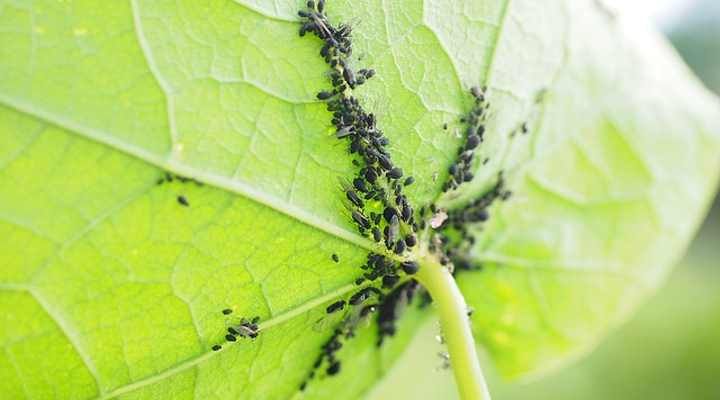
Black aphids on the underside of a leaf
In the greenhouse, aphids could be tiny black bugs on tomato plants or other crops.
Black aphid plant damage is the best way to identify the bugs. The tiny black pests suck out the sap of foliage. The damage results in stunted growth, curled leaves, yellow leaves, and leaf spot. Additionally, the nasty bugs excrete honeydew—a sweet sticky amber liquid.
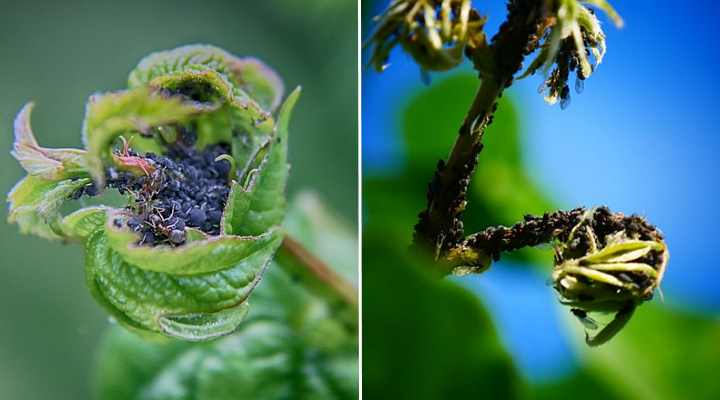
Black aphid infestation
Black aphids that attack garden plants may also attract ants. The ants are drawn to sticky-sweet honeydew because they use it for food. As a result, they will often protect aphids from attack by predators.
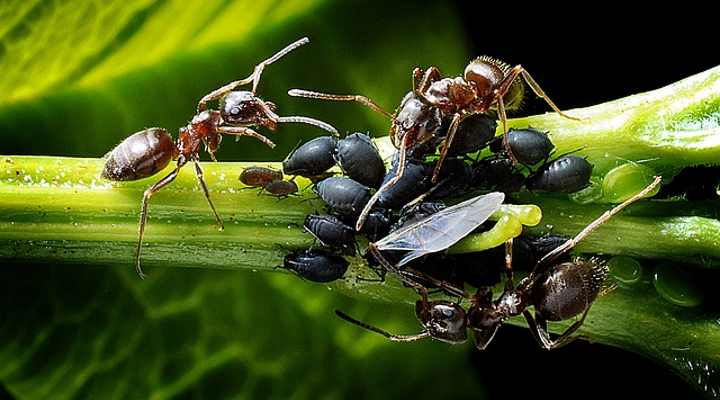
Ants feeding on the honeydew left behind by black aphids
The honeydew also causes another problem—black fungal growth. A black sooty substance can appear on leaves. While it may not kill a plant, the black soot can interfere with photosynthesis.
Small Black Bug Identification: Aphids are black bugs, almost invisible to the naked eye. They have a black, tear-shaped body and are easier to notice when feeding in groups. Look for black speckles on the underside of leaves when inspecting plants for aphids.
How to get rid of black aphids
Neem oil is the best natural solution to kill black aphids. Combine 2 tsp. organic neem oil, 1 tsp. liquid Castile soap, and a quart (1 l) of water in a spray bottle. Spray copious amounts of the natural pesticide on the plant leaves and stems and leave them to dry.
For best results, use the neem oil spray once a week to kill aphids, stop larvae from developing or prevent eggs from hatching.
Related reading: Effective ways to kill aphids on plants.
Flea Beetles (Alticini)
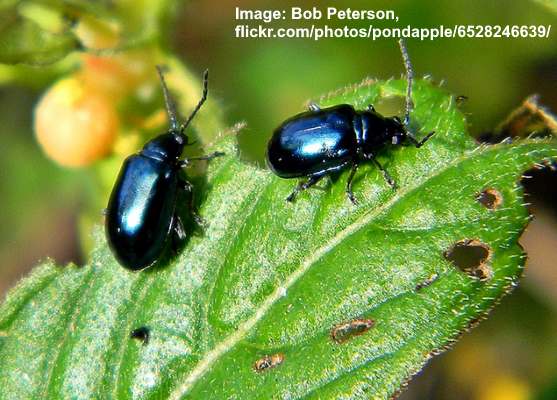
Metallic blue flea beetles chew on a leaf
Flea beetles are tiny black bugs that can jump and fly. The black insects have an oval body and measure 0.1” (2.5 mm) long. Although typically black, flea beetles can be bronze or brown with a metallic shine. Some tiny black flea beetles have yellow stripes on their back.
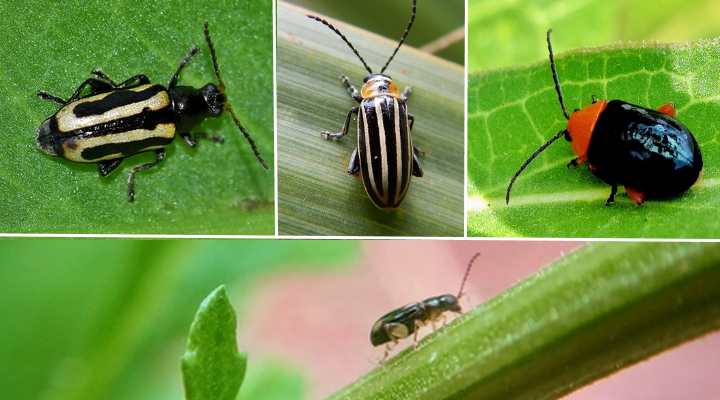
Flea beetles include various species with different coloration
Black flea beetles tend to attack garden plants and vegetables. You can find these garden beetles chewing holes in the leaves of plants in the mustard family or other cruciferous vegetables. The black bugs are found on tomato plants, and they can also destroy certain types of ornamental flowering plants.
Black flea beetle damage usually occurs on young tender plant leaves. The bugs emerge from the soil in spring and start feeding. Beetle damage can result in holes in leaves or skeletonized leaves.
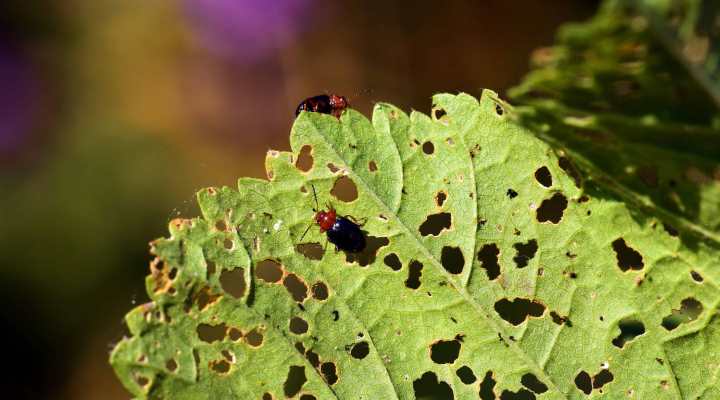
Flea beetles damage
Flea beetle larvae are small, cream-colored worms that also damage plants. They live underground and feed off the roots and tubers, as well as the roots of saplings.
Small Black Bug Identification: Flea beetles are identifiable as small, hard-shelled black bugs with oval bodies. The tiny bugs are often seen crawling on leaves in spring and summer, especially during dry weather. You may notice stripes on some species, and they will jump when disturbed.
How to get rid of flea beetles
Use diatomaceous earth (DE) to eradicate the small black garden bugs. Sprinkle diatomaceous earth around your crops and ornamental plants. The non-toxic white powder is abrasive to beetles and will destroy their exoskeletons, causing them to dehydrate and die. You will need to replace DE after it rains and only apply it to dry ground.
Alternative methods include spraying plants with a neem oil solution. In the vegetable garden, using row covers can help protect plants from flea beetles.
Black Thrips (Thysanoptera)

Thrips are tiny insects that include numerous species and can cause extensive damage to plants
Black thrips are tiny winged black bugs that cause significant harm to plants. The black insects have slender bodies and are so little that they may look like black pinpricks on the underside of leaves. Thrips are tiny black bugs that infest houseplants and they are usually about 0.04” (1 mm) long.
Thrips look like minute lobsters with a pointed nose and two antennae. However, the microscopic black bugs are usually only noticed when they start feeding on plants. To tell if you have a problem with black thrips, put a sheet of white paper under the leaves. Tap on the leaves. Any thrips will fall onto the paper and appear as black specks.
Black thrips plant damage may look like tiny black or green dots on the underside of leaves. These specks may enlarge to look like yellowish stains on leaves. In time, leaves will wither and die. Also, infected flowering plants may stop producing flowers. You may also notice bumps (galls) on plant foliage.
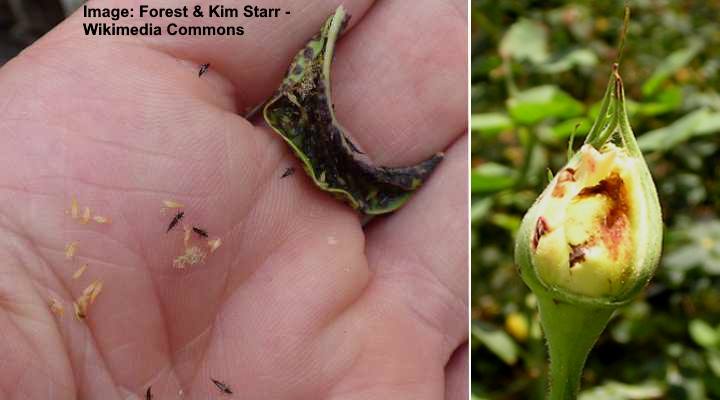
Close-up picture of thrips damage: black leaf discoloration (left picture) and rose bud damage (right picture)
Small Black Bug Identification: To look for signs of thrips on plants, examine the underside of leaves closely. Thrips will appear as tiny black speckles on leaves and buds. You may need to take a magnifying glass to look for slender black bugs. Leaves may also appear spotted.
How to get rid of black thrips
Use Spinosad to get rid of thrips and protect your plants from further damage. This natural substance from soil bacterium eventually kills the nasty sap-sucking insects.
Alternative solutions for killing thrips are neem oil, insecticidal soap sprays, or using yellow sticky traps. However, thrips can be so invasive that a combination of solutions is typically necessary to eradicate the black bugs.
Related reading: How to get rid of thrips on plants.
Black Spider Mites (Tetranychidae)

A close up image of spider mites Tetranychus urticae
Black spider mites are incredibly small bugs that look like black seeds under leaves. The minuscule insects can range from green to dark brown, almost black. The dark-colored mites measure less than 0.04” (1 mm). Because they are so tiny, you usually notice webbing before spotting the bugs.
Have you noticed tiny red bugs on your plants? They could be red spider mites.
Black spider mite damage is caused by the pesky bugs sucking sap from plant leaves. First, you may notice yellow or brown spots or blotches on leaves. In time the leaves look like they are covered in yellow freckles (leaf stippling). In time, the plant can stop growing and eventually die.
Small Black Bug Identification: The easiest way to identify black spider mites is to look for tell-tale strands of silky threads hanging from leaves. In time, the spider mites will develop webbing on plants for protection. The web-like structures help to tell spider mites apart from other black bugs.
How to get rid of black spider mites
To eliminate spider mites from houseplants, shower the foliage in the bathroom to remove most of the bugs. Then spray a neem oil solution once a week to kill any remaining spider mites, their larvae, and eggs.
Related reading: How to get rid of spider mites for good.
Black Scale Bug (Saissetia oleae)
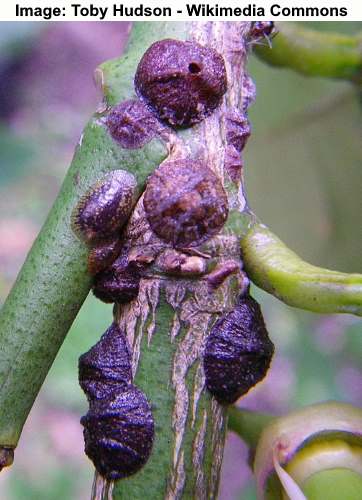
Black Scales look like dark growths on stems and underside of leaves
Black scale is a sap-sucking bug that looks like dark brown growths on landscape plants. The bugs have a round shape with a distinctive H-shaped ridge on their back. The black scale insects measure 0.2” (5 mm) wide and 0.12” (3 mm) wide. The black bumps can be found on stems and the underside of leaves.
Black scale bugs rarely affect houseplants and primarily affect fruit trees, cottonwood trees, and olive trees. You can learn what to do about getting rid of houseplant scale insects.
Black scale damage results in a loss of vigor in once healthy plants. Very often, weak plant growth goes together with sooty mold on leaves and honeydew on stems.
Small Black Bug Identification: Black scale bugs look like bumpy growths on woody stems and under leaves. The rounded insects rarely move but stay under their brownish-black shells. Black scale is accompanied by honeydew and sooty mold.
How to get rid of black scale bugs
Pruning affected branches is the easiest way to rid an ornamental shrub or tree of black scale bugs. You can also crush the insects by hand or dab them with rubbing alcohol to kill them on contact.
Further reading: How to Kill Scales on plants.
Related articles:
